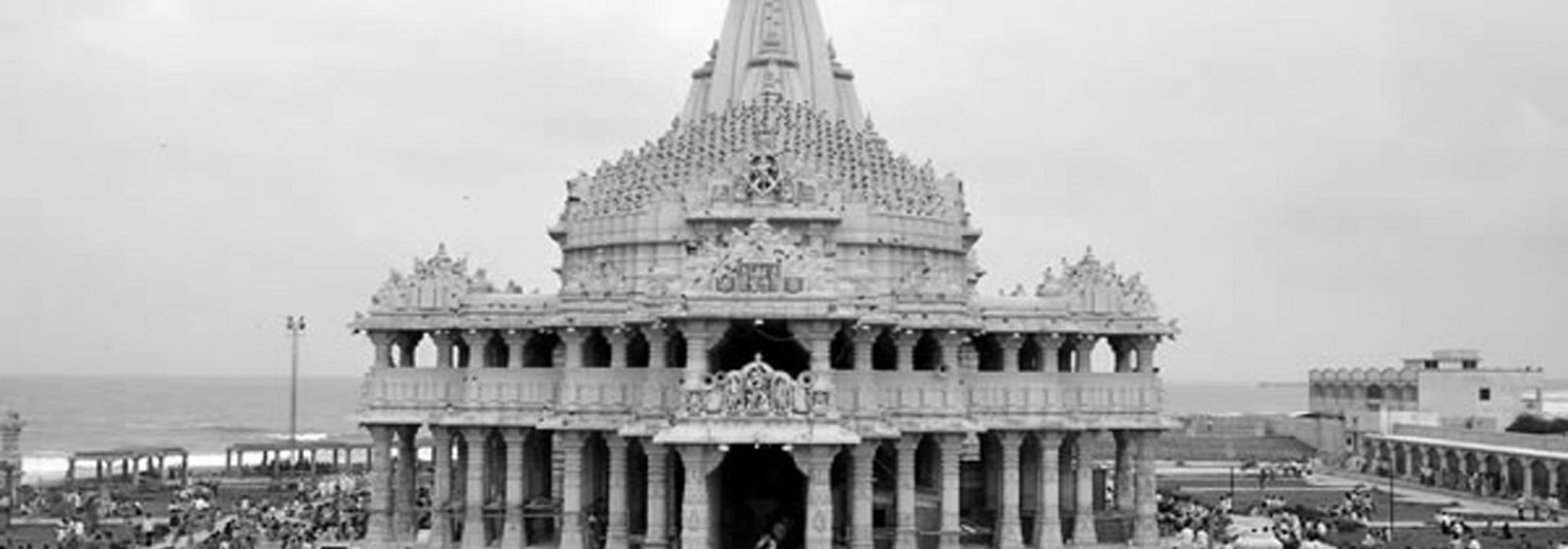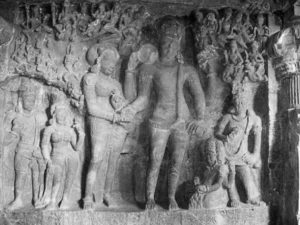Introduction
The conception, origin, evolution, and development of temples as physical, architectural structures is perhaps as old as the dawn of human civilisation as we know it. Temples represent one of the finest, deepest, grandest, and most profound expressions of the Human Spirit of awe, wonderment, and a timeless yearning for spirituality, philosophy, art and creativity etched in stone, wood, and other mediums.
Indeed, when we notice the various forms of temples from the earliest of civilisations—Minoan, Greek, Roman, Egyptian, Mayan, Chinese, Incan, and most certainly, Bharatiya—we notice precisely this same spirit of yearning. In fact, the etymology of the word, “temple” can be traced to the Latin term, “Templum” meaning, a shrine, sacred place, an open area meant for augury, and so on. However, almost no temple of the non-Bharatiya antiquarian civilisations survives today thanks largely to their destructive encounter with Christianity and Islam. But it is also notable that these two Prophetic religions with their zealous abhorrence against and prohibition of what they call “idol worship,” “but,” etc, nevertheless have countless mosques, dargahs, churches, cathedrals, shrines, etc. In a way, this represents the triumph of the aforementioned innate spiritual longing over manmade, prophetic prohibitions.
The role, significance and eminence of Hindu temples becomes abundantly clear when we regard them in this protracted historical backdrop. As is well known, the words for “temple” in Sanskrit and Bharatiya Bhasha are variously, “Devalaya,” “Devasthanam,” “Aalya,” “Mandir,” “Kovela,” “Koil,” and so on. A quick derivation of the etymology of “Devalaya” is as follows: Devasya (Devaanaam) Alayah. This means, “a place in which resides light, sport, victory, transaction, prayer (stuti), joy, bliss, dream, beauty, and dynamism.” For an excellent and more detailed exposition, one can refer Devalayatattva by Shatavadhani Dr. R Ganesh.
While the pre-Christian Western civilisations developed temple culture largely as places for public congregation, divination, and augury, Bharata elevated it in an all-encompassing sense. For instance, the English word, “temple” also means the locations spanning the two sides of the forehead, which is flat, akin to a sacred altar. In the Bharatiya conception, the entire body is itself a temple suggested by slokas such as Dehah devalayah proktah jivo devah sanatanah, hrudya tadvijaaneeyaat vishwasyaayatanam mahat, and so on. Thus, the feet are the main doors, the reproductive organ the Dhwajasthambha, the stomach the Balipeeta, the heart the Navaranga, the neck the Sukanasi, and the head the Garbhagriha. In short, a temple represents and encompasses all three staras or stages: Adhibhuta, Adhidhaiva, and Adhyatma.
The following quotations elegantly and accurately capture the essence of the philosophy underlying Devalaya (Note: I shall use the terms “temple” and “Devalaya” interchangeably in this essay).
I] The underlying philosophy of temples is rooted in an attempt to experience the Brahmanda—which is space-time neutral—that is ensconced in the Pindanda, which is subject to the vagaries of space and time.[i]
II] Temples are built in order to remind the devotee of Parameswara’s creation and the Human Being’s body and the evolution of his Jiva [life, life-force] by carving sculptures and Murtis.[ii]
More fundamentally, the earliest conceptions of temples emanated from the Vedic vision of the heart as a cave—for example, nihitam guhaayaam, hrudayam tadvijaaneeyaat, the extraordinary Jnana Yagna verses occurring towards the end of the Mahanarayana Upanishad. The summary of these conceptions is a visualisation that in our heart resides the Parameswara (or the highest knowledge) in the form of light and it should be our goal and aim to realise this light. This conception strikes us when we notice the fact that the Mula-Murti resides in the Garbha Griha, which is the heart of any temple.
On the physical plane, it is undeniable that temples as we know them originated[iii] from Yagna Vedis. For a comprehensive discussion on this topic, one can again refer to Shatavadhani Dr. Ganesh’s Devalayatattva.
The Devalaya Ecosystem
The foregoing introduction serves to illustrate the sort of the firm foundation which in turn paved the way for the evolution of what can be called as the Devalaya Ecosystem. The Devalaya Ecosystem is a socio-cultural accomplishment and a civilizational summit that is unparalleled anywhere in human history. The fact that even today there is a new temple being built, some old temple being renovated in some corner of Bharata almost everyday testifies not only to the endurance and longevity of its roots but is also an eminent proof that as long as Sanatana Dharma survives in the world, it will invariably find its expression in temples.
From the perspective of the Trigunas (basic attributes or qualities of human nature), namely, Sattva (balance, serenity, etc), Rajas (activity, passion, vigour, etc), and Tamas (laziness, indolence, stupor, etc), a Devalaya is the purest architectural, sculptural, and artistic embodiment of the Sattva Guna. By itself, it does nothing, it takes no action. But by its mere existence it inspires, motivates and guides all noble human endeavours in multiple realms. A Devalaya thus becomes the pillar and the rest house supporting, accommodating, and enabling the attainment of Dharma and fulfilling the various duties and activities related to Artha.
In the realm of Dharma, it is the place to perform Acaras (customs, ceremonies, rituals, celebrations) like Namakarana (naming ceremony), aksharabhyasa (initiation ceremony where a child learns to write alphabets), vivaha (wedding), and so on. These ceremonies are part of the individual discharging his/her Dharmic duties. In the realm of the community, the Devalaya is the place for conducting mass marriages, Utsavas, Jatras, Annadanam, and other such celebrations. Indeed, not too long ago, the Devalaya was also the place where justice was dispensed as seen even today in Dharmasthala.
On the plane of the Adhidaivika (divine, spiritual), we can consider the Deity of Vastushastra, Viswakarma. His nine sons including Malakara, Darukara, Kuvindaka, Kumbhakara, Sutradhara and others represent the respective professions of garland-maker, carpenter, weaver, potter, and sculptor. These apart, we also have the farmer, chef, runner (or messenger), singer, artisan and accountant among others. In other words, we do not fail to notice in these instances, how these professions are sanctified by making them the descendants of a particular Deity. Every profession had its rightful place and every professional could make a living through honest labour. Needless, it’s equally clear how all of these professions make up an entire economic system spawned and supported solely by a temple.
It is precisely this that we observe in every temple town across Bharatavarsha: Kashi, Mathura, Kanchi, Chidambaram, Tirumala-Tirupati, Madurai, Palani, Pandarapura, Badirnath, and Puri. We can also consider a tangential facet here: any Daana (donation, endowment, gift) given to a temple became what’s known as Devasva or the property of the Deity over which nobody (including the donor and the king) had the right. This in a way illustrates how well thought out the system of checks and balances that were implemented. Dr. S Srikanta Sastri explains[iv] the various facets of the Devalaya Ecosystem quite picturesquely in a passage that merits quoting at length:
…temples occupied a prominent place from the perspective of education, fine arts, [reflected the] economic condition [of the kingdom] and social service.
Thus, people had a firm belief and faith in the pious act of donating to temples. [Donors included] everybody from the monarch to the most ordinary citizen…temples were governed and maintained by a duly elected board. They distributed money, food grain, and seeds to farmers from the Deity’s Treasury…[temples] were also engaged in moneylending…temples conducted various celebrations like Pakshotsava [fortnightly utsavas], Maasotsava [monthly utsavas], Brahmotsava, and oversaw the distribution of the harvest derived from temple lands.
Theatre and dance halls organized dramas during Utsava days in both Sanskrit and Desha Bhashas. Music and dance recitals offered as Seva for the Deity immensely enriched art forms like classical music, Bharatanatyam, and Vastushilpa [sculpture art]. Moral and spiritual discourses by learned scholars, Yatis, and such other eminences were drawn from the Vedic and Puranic lore thereby instilling and reinforcing Dharma among the pilgrims and others who visited the temple.
There were also lecture halls for imparting higher education in Veda, Vedanga, Medicine and other subjects by teachers and scholars employed by the temple. Students were given free scholarship and boarding and lodging…
Massive temples were secure like fortresses and contained an abundance of food grain, water and other supplies and provided shelter to refugees during wartime…Because Hindu kings regarded temples as sacred spaces, they deferred harming or despoiling them even slightly even if this caution meant certain defeat in war….
Temples in island nations like Java, Bali, Sumatra, Burma and Cambodia were built following the ideals and physical plan of various Indian temples.
As with most facets of our culture and society, temples also show a remarkable sense of unbroken continuity and cultural unity in that they are still a living memory. The majestic Somanatha Devalaya that was rebuilt in 1951 is a superb testimony to this inherited knowledge-heritage, traditions, and rituals which were preserved intact even after hundreds of years of its repeated destruction and alien rule of India. Similarly, many of the ancient temple towns that have also survived brutal shocks but still continue to thrive also echo the same.
Art forms such as Natyamelas, Harikata, Yakshagana, Kudiyattam, and Kathakali are the direct offshoots of this same, sprawling Devalaya Ecosystem. For centuries, these art forms became the immensely popular and excellent vehicles for transmitting a towering, beautiful, and sublime culture. One can refer to Rallapalli Anantakrishna Sarma’s evocative and vividly descriptive essays to glean valuable details and insights about the contribution of the Devalaya Ecosystems especially during the Vijayanagara Era.
To be Continued
Notes:
[i] Devalayatattva: Pg 166: Shatavadhani Dr. R Ganesh
[ii] Bharateeya Samskruti: Pg 171: Dr. S Srikanta Sastri
[iii] Other excellent works include Prof S K Ramachandra Rao’s Indian Temple Traditions, Stella Kramrisch’s The Hindu Temple (in two volumes), and Ananda K Coomaraswamy’s writings on Indian art and sculpture.
[iv] Ibid: PP 171-72
















































